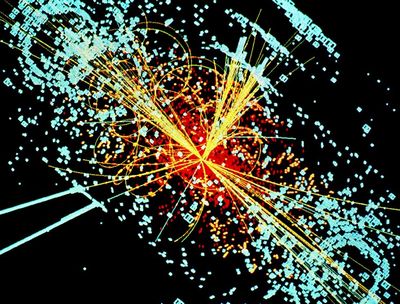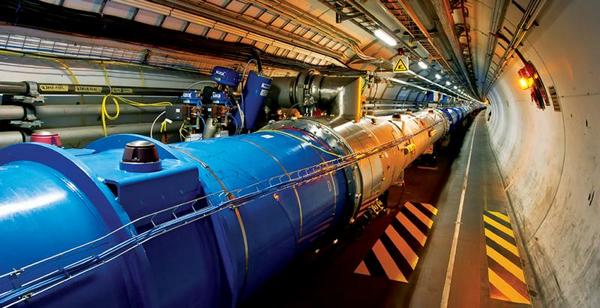Higgs Boson: the God Particle or Fake?

Content:
The elementary particle Higgs boson was named after the British physicist Peter Higgs, who theoretically predicted its existence back in 1964. Higgs Boson is one of the most mysterious and amazing elementary particles in modern physics. Higgs Boson caused a lot of debate in the scientific community. Someone even says that Higgs Boson is “the God Particle.” On the other hand, there are skeptics who claim that the Higgs boson does not exist and this is all a big fake. What is boson particle, how it was discovered and many more interesting facts are found in this article.
Definition
In order to explain “what is the god particle” as simple as possible it is necessary to resort to the language of allegories and comparisons. Although, all the allegories and comparisons that relate to the physics of elementary particles, can not be true and accurate. The electromagnetic field or quantum wave is neither a field nor a wave in the sense in which people usually imagine them, just as the atoms themselves are not at all reduced copies of the Solar System. Although allegories and comparisons still do not inform the very essence of those things that occur in quantum physics, they bring us closer to an understanding of these things.
An interesting fact: in 1993, the British Minister of Education announced a competition for the simplest explanation of what the Higgs boson is. The winner was an explanation related to the party.
So, imagine a populous party, some celebrity enters the room (“rock star”) and guests immediately begin to move. Everyone wants to talk with the “star”, while the “star” moves slower than all the other guests. Then people gather in separate groups, where they discuss some news or gossip associated with the star and randomly move from group to group. As a result, it seems that people discuss gossip, closely surrounding the celebrity, but without her/his direct participation. So, all the people participating in the party are the Higgs field, groups of people are outrageous of the field, and the celebrity itself, because of which they formed is the Higgs boson.
If this allegory is not completely clear to you, then here is another one: imagine a smooth billiard table with balls on it – balls are elementary particles. These balls easily fly away in different directions and move everywhere without obstacles. Imagine that the billiard table is covered with some kind of adhesive mass that makes it difficult for balls to move along it. This sticky mass is a Higgs field; the mass of this field is equal to the mass of particles that stick to it. The Higgs boson is a particle that corresponds to this sticky field. If you hit the billiard table with this sticky mass strongly, then a small amount of this sticky mass will form a bubble for a while, which will soon spread again on the table, and so this bubble is the Higgs boson.

Discovery
When was the Higgs boson discovered? As we wrote at the beginning, the Higgs boson was first discovered theoretically by the British physicist Peter Higgs. He suggested that some elementary particle that was not yet known is involved in the process of the mechanism of spontaneous breaking of electroweak symmetry in a standard model of particle physics. It happened back in 1964. The scientists began to search for the real existence of this elementary particle, however, for many years scientists suffered a fiasco. Because of this, some scientists jokingly began to call the Higgs boson – “cursed particle” or “the God particle.”
The Large Hadron Collider was built in 2012, in order to confirm or disprove the existence of this mysterious “the God particle”. The Large Hadron Collider is a giant accelerator of elementary particles. Experiments on Collider experimentally confirmed the existence of the Higgs boson. Peter Higgs won the Nobel Prize in Physics for this discovery in 2013.
Returning to our analogy about the billiard table, in order to see the Higgs boson, physicists had to strike with force the adhesive mass that lies on the table to get a bubble from it – the Higgs boson. So, the accelerators of elementary particles of the XX century were not so powerful to provide a “bubble”. Only the Large Hadron Collider helped scientists “knocking the table” and see the ” the God particle.”

Importance
To a person who is far from science in general (and from physics in particular), the search for some elementary particle may seem meaningless, but the discovery of the Higgs boson is of considerable importance for science. First of all, our knowledge of the boson will help in the calculations that are carried out in theoretical physics when studying the structure of the Universe.
Physicists suggested that the Higgs bosons filled the whole space around us. When interacting with other elementary particles, the bosons transfer them their mass, and if it is possible to calculate the mass of certain elementary particles, then the mass of the Higgs boson can be found. And if we have the mass of the Higgs boson, then by going in the opposite direction, we can also calculate the masses of other elementary particles.
Danger
British scientist Stephen Hawking had some concerns about the Higgs boson and experiments with it. According to Hawking, the Higgs boson is an extremely unstable elementary particle and, as a result of a certain set of circumstances, can lead to the disintegration of the vacuum and the complete disappearance of such concepts as space and time. Yet do not worry, it is necessary to build a collider the size of our entire planet in order for something like this to happen.
Properties
- The Higgs boson, as well as other elementary particles, is exposed to gravity.
- The Higgs boson has zero spin (angular momentum of elementary particles).
- The Higgs boson has an electric and color charge.
- There are 4 main channels for the production of the Higgs boson: after the merger of 2 gluons (the main one), the fusion of WW or ZZ pairs, accompanied by the W or Z boson, together with the top quarks.
- The Higgs boson decays into a pair of b-quark-b antiquark, into 2 photons, into two pairs of electron-positron and/or muon-antimuon, or into a pair of electron-positron and/or muon-antimuon with a pair of neutrinos.
Word to Skeptics
There are skeptics who argue that the Higgs boson doesn’t exist in reality. The Higgs boson is a fake and was invented by scientists for the selfish purpose of mastering taxpayers’ money.
References and Further Reading
- “LHC experiments delve deeper into precision”. Media and Press relations (Press release). CERN. 11 July 2017. Retrieved 23 July 2017.
- M. Tanabashi et al. (Particle Data Group) (2018). “Review of Particle Physics”. Physical Review D. 98 (3): 030001. doi:10.1103/PhysRevD.98.030001.
- Jump up to: a b c d e f g LHC Higgs Cross Section Working Group; Dittmaier; Mariotti; Passarino; Tanaka; Alekhin; Alwall; Bagnaschi; Banfi (2012). “Handbook of LHC Higgs Cross Sections: 2. Differential Distributions”. CERN Report 2 (Tables A.1 – A.20). 1201: 3084. arXiv:1201.3084. Bibcode:2012arXiv1201.3084L. doi:10.5170/CERN-2012-002.
- ATLAS collaboration (2018). “Observation of H>bb decays and VH production with the ATLAS detector”. Physics Letters B. 786: 59–86. arXiv:1808.08238. doi:10.1016/j.physletb.2018.09.013.
- CMS collaboration (2018). “Observation of Higgs Boson Decay to Bottom Quarks”. Physical Review Letters. 121 (12): 121801. arXiv:1808.08242. doi:10.1103/PhysRevLett.121.121801. PMID 30296133.

Author: Pavlo Chaika, Editor-in-Chief of the journal Poznavayka
When writing this article, I tried to make it as interesting and useful as possible. I would be grateful for any feedback and constructive criticism in the form of comments to the article. You can also write your wish/question/suggestion to my mail pavelchaika1983@gmail.com or to Facebook.

